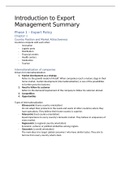Samenvatting
Introduction to Export Management Summary
- Vak
- ES-2SEM-E4-17
- Instelling
- Haagse Hogeschool (HHS)
This summary is written on the entire course of Introduction to Export Management given at European Studies at THUAS. It includes chapter 1-11 of the book Export Planning and some extra's from the lectures.
[Meer zien]





